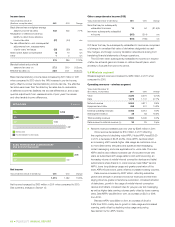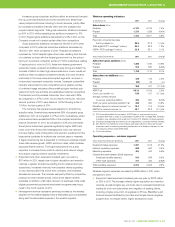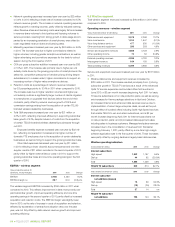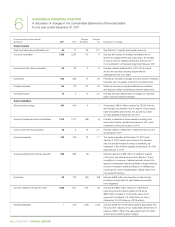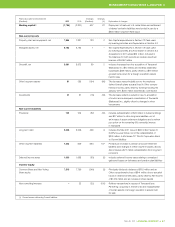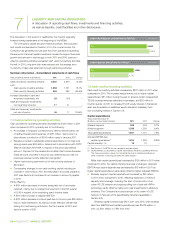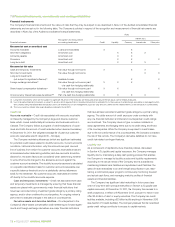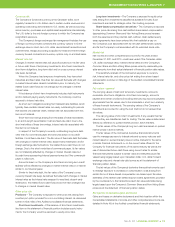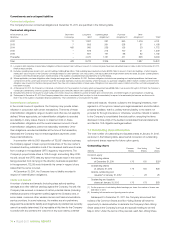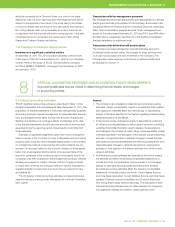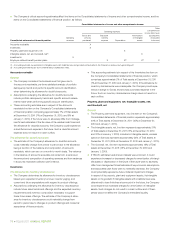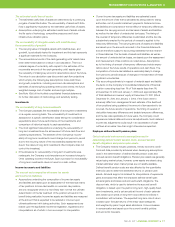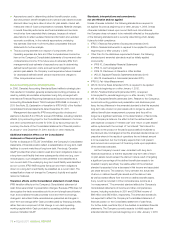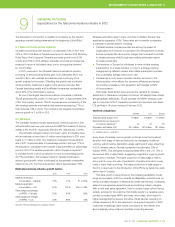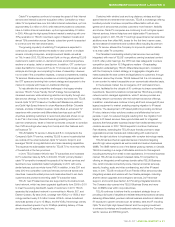Telus 2011 Annual Report Download - page 76
Download and view the complete annual report
Please find page 76 of the 2011 Telus annual report below. You can navigate through the pages in the report by either clicking on the pages listed below, or by using the keyword search tool below to find specific information within the annual report.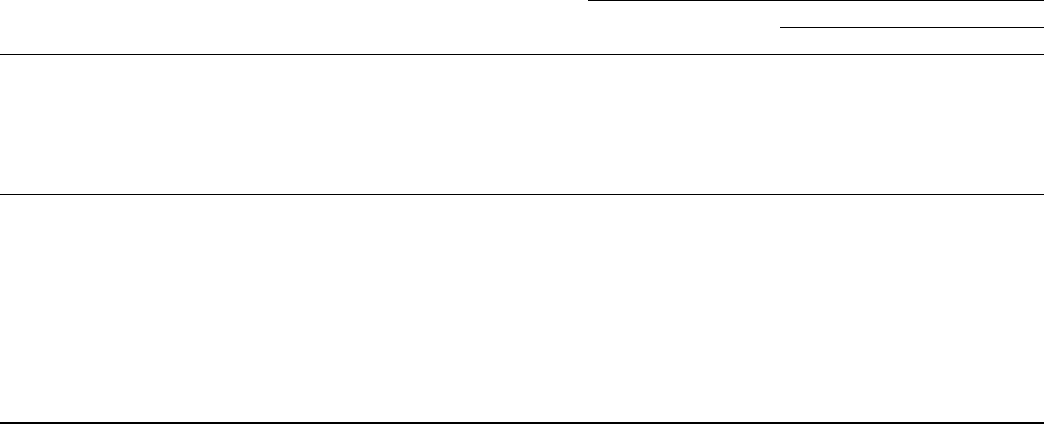
72 . TELUS 2011 ANNUAL REPORT
7.8 Financial instruments, commitments and contingent liabilities
Financial instruments
The Company’s financial instruments and the nature of risks that they may be subject to are described in Note 4 of the Audited consolidated financial
statements and are set out in the following table. The Company’s policies in respect of the recognition and measurement of financial instruments are
described in Note 2(c) of the Audited consolidated financial statements.
Risks
Recognition and measurement Market risks
Financial instrument accounting classification Credit Liquidity Currency Interest rate Other price
Measured at cost or amortized cost
Accounts receivable Loans and receivables X X
Short-term obligations Amortized cost X X X
Accounts payable Amortized cost X X
Provisions Amortized cost X X X
Long-term debt Amortized cost X X X
Measured at fair value
Cash and temporary investments Fair value through net income X X X
Short-term investments Fair value through net income X X
Long-term investments
(not subject to significant influence)(1) Available-for-sale X X
Foreign exchange derivatives(2) Fair value through net income; part X X X
of a cash flow hedging relationship
Share-based compensation derivatives(2) Fair value through net income; part X X X
of a cash flow hedging relationship
Cross currency interest rate swap derivatives(2)(3) Part of a cash flow hedging relationship X X X X
(1) Long-term investments which are not subject to significant influence of the Company are measured at fair value if the fair values can be reliably measured.
(2)
Use of derivative financial instruments is subject to a policy which requires that no derivative transaction be entered into for the purpose of establishing a speculative or leveraged position
(the corollary being that all derivative transactions are to be entered into for risk management purposes only) and sets criteria for the creditworthiness of the transaction counterparties.
(3) The cross currency interest rate swap derivatives matured in fiscal 2011.
Credit risk
Accounts receivable – Credit risk associated with accounts receivable
is inherently managed by the Company’s large and diverse customer
base, which covers substantially all consumer and business sectors in
Canada. The Company follows a program of credit evaluations of custo-
mers and limits the amount of credit extended when deemed necessary.
At December 31, 2011, the weighted average life of past due customer
accounts receivable was 61 days (2010 – 59 days).
The Company maintains allowances (which are significant estimates)
for potential credit losses related to doubtful accounts. Current economic
conditions, historical information, why the accounts are past due and
line of business from which the customer accounts receivable arose are
all considered when determining whether past-due accounts should be
allowed for; the same factors are considered when determining whether
to write off amounts charged to the allowance account against the
customer account receivable. The doubtful accounts expense is calculated
on a specific-identification basis for customer accounts receivable over
a specific balance threshold and on a statistically derived allowance
basis for the remainder. No customer accounts receivable are written
off directly to the doubtful accounts expense
Cash and temporary investments – Credit risk associated with cash
and temporary investments is managed by ensuring that these financial
assets are placed with: governments; major financial institutions that
have been accorded strong investment grade ratings by a primary rating
agency; and/or other creditworthy counterparties. An ongoing review is
performed to evaluate changes in the status of counterparties.
Derivative assets and derivative liabilities – Counterparties to the
Company’s share-based compensation cash-settled equity forward agree-
ments and foreign exchange derivatives are major financial institu tions
that have all been accorded investment grade ratings by a primary rating
agency. The dollar amount of credit exposure under contracts with
any one financial institution is limited and counterparties’ credit ratings
are monitored. The Company does not give or receive collateral on
swap agreements and hedging items due to its credit rating and those
of its counterparties. While the Company is exposed to credit losses
due to the non-performance of its counterparties, the Company considers
the risk of this remote. The Company’s derivative liabilities do not have
credit risk-related contingent features.
Liquidity risk
As a component of capital structure financial policies, discussed
in Section 4.3 Liquidity and capital resources, the Company manages
liquidity risk by: maintaining a daily cash pooling process that enables
the Company to manage its liquidity surplus and liquidity requirements
according to the actual needs of the Company and its subsidiaries;
maintaining bilateral bank facilities and syndicated credit facilities; the
sales of trade receivables to an arm’s-length securitization trust; main-
taining a commercial paper program; continuously monitoring forecast
and actual cash flows; and managing maturity profiles of financial
assets and financial liabilities.
The Company has significant debt maturities in future years (see
chart of long-term debt principal maturities in Section 4.3 Liquidity and
capital resources). At December 31, 2011, the Company has access to a
shelf prospectus, in effect until November 2013, pursuant to which it can
offer $2.5 billion of debt or equity securities. The Company has credit
facilities available, including a $2 billion facility expiring in November 2016
(see Section 7.5 Credit facilities). The Company believes that its invest ment
grade credit ratings contribute to access to capital markets.


